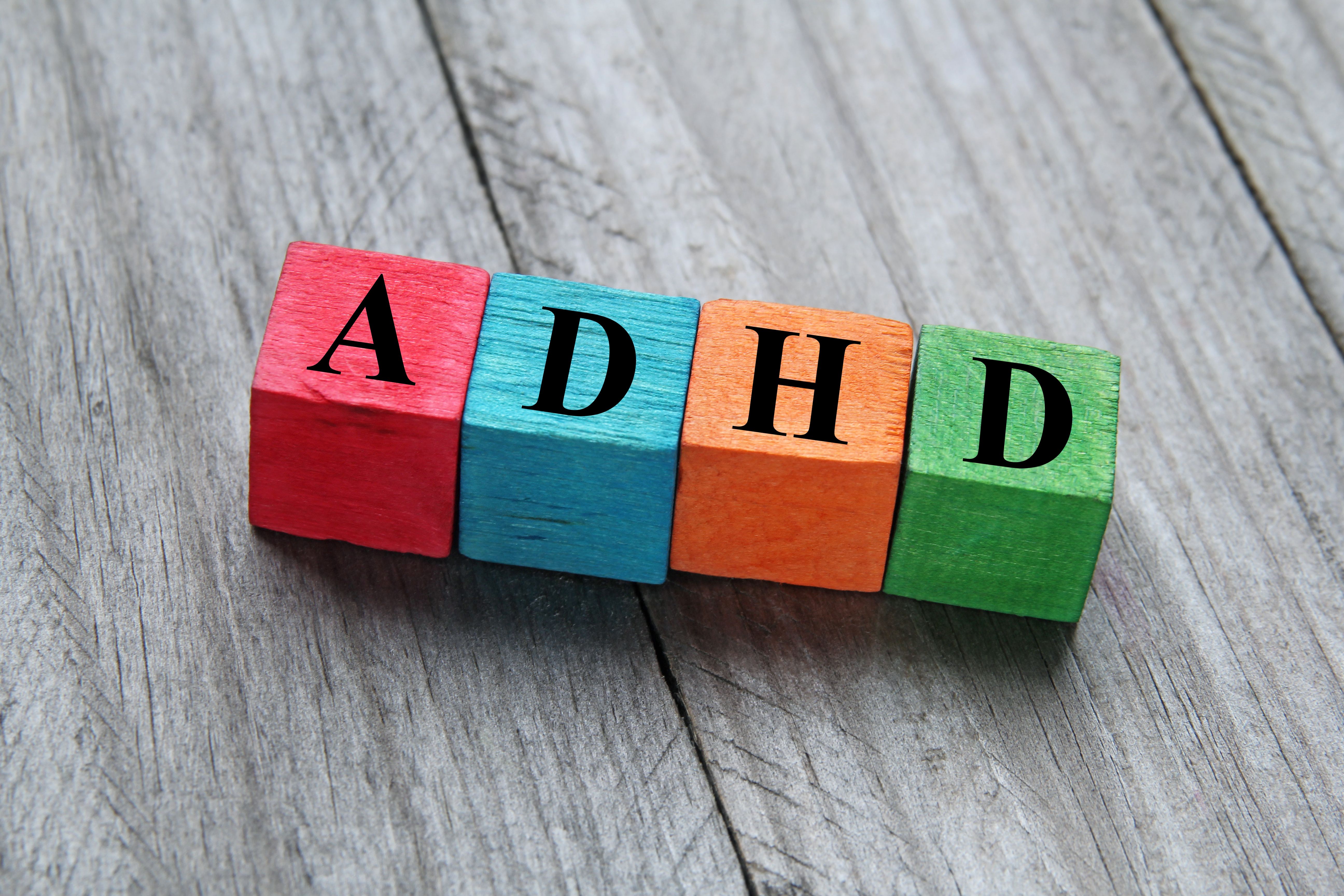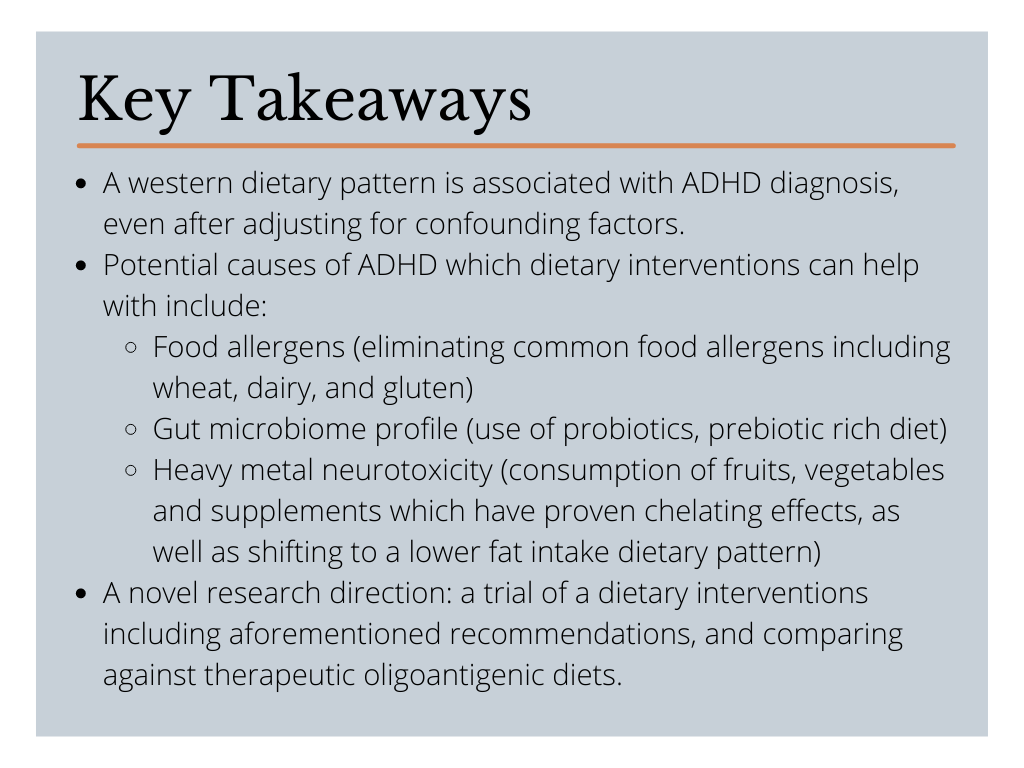Article
Dietary Interventions for ADHD: Emerging Research and Considerations
Author(s):
What is the connection between ADHD diagnosis and a Western dietary pattern?
chrupka_AdobeStock

There has been increasing interest in the role that diet and supplements play in the treatment of attention-deficit/hyperactivity disorder (ADHD) symptoms, from patients and researchers alike. Diet is an important treatment approach to consider, as it is a lifestyle change rather than a medication. Additionally, at least 10% to 30% of children with ADHD are non-responsive to, or experience adverse effects from, ADHD medications.1
A dietary approach to ADHD can be complementary to a conventional pharmacological approach, giving patients and their families more options toward a personalized treatment plan. This article will examine current research about diet and ADHD, review important potential mechanisms (including the role of the immune system, gut microbiome, and toxic heavy metals), and comment on promising new avenues for the treatment of ADHD.
Elimination Diets and the Immune System
Elimination diets have been developed for ADHD since the 1970s, beginning with the Feingold diet, which was based on a hypothesis that a diet without natural salicylates and artificial food coloring could improve symptoms in hyperactive children.2
Of more recent research interest has been the oligoantigenic diet, a dietary strategy that removes major common food allergens including wheat, dairy, and gluten, restricting the diet to a few hypoallergenic foods.3
There have been a number of randomized controlled trials (RCTs) showing the effectiveness of the oligoantigenic diet in patients with ADHD. A 2012 meta-analysis across 6 controlled trials including 195 patients reported an effect size of 0.29, and it was concluded that about one-third of the children with ADHD show an excellent (>40% symptom reduction) response.4 It is not yet clear whether there are biomarkers or other indicators to predict if a patient belongs to a subset that responds more favorably to the oligoantigenic diet.3
The mechanism behind the efficacy of the oligoantigenic diet is still under investigation. Patients with ADHD are more likely to develop allergies, and vice versa, which has led researchers to investigate potential IgE responses to foods in children with ADHD.5 So far, there has been no convincing evidence to suggest an IgE mediated mechanism; for example, there were no differences found in allergen skin-prick testing results between children with ADHD and control patients.6 Potential mechanisms involving serum IgG levels have also been investigated, but no associations have been found between IgG levels and ADHD symptom remission.3
Gut Microbiome
There has been increasing evidence to suggest that the gut microbiome plays an important role in the gut-brain axis, and that dysbiosis may contribute to several neurodevelopmental disorders including ASD and ADHD.7
The gut microbiome has multiple ways it can influence brain development and functioning via its direct connections with the vagus nerve, its interactions with the immune system, and by directly altering the level of neurotransmitters like serotonin and dopamine. Changes in composition of the gut microbiome, therefore, can affect neurodevelopment and functioning.3
For instance, researchers investigated the profile of gut microbiota in patients with ADHD and found that these patients had a 12.7% to 20.5% increased Bifidobacterium genus. It was also found that an increased proportion of Bifidobacteriumcould predict the function of dopamine precursor synthesis and were associated with diminished neural reward anticipation on functional magnetic resonance imaging (fMRI).8
Another potential indication of the involvement of the gut microbiome in ADHD comes from research on probiotics. A recent RCT examined the role of the probiotic strain Lactobacillus rhamnosus GG (LGG) in patients with ADHD and found that children and adolescents who received LGG supplementation reported better health-related quality of life compared to their peers who received the placebo. However, there were no significant reported differences in the ADHD symptom ratings provided by parents and teachers.9
Heavy Metals
Exposure to heavy metals is one of the most reported environmental factors implicated in ADHD.10 Many heavy metals are known developmental neurotoxicants including lead, mercury, arsenic, manganese, and selenium. In utero, these metals are transferred from the mother to fetus via the placenta, and with additional exposure during infancy and adolescence, children can develop neurodevelopmental deficits that may be seen in disorders such as ADHD and autism spectrum disorder (ASD).11 The developing human brain is particularly vulnerable to toxic chemical exposures, where levels of exposure that would have little or no adverse effect in an adult can result in permanent brain injury in an infant.12
There are a number of studies that corroborate the connection between ADHD and heavy metals. A 2020 study in Guangzhou, China, for example, reported that children with ADHD presented with higher urine concentrations of chromium, manganese, cobalt, nickel, copper, molybdenum, tin, barium, and lead,13 while a study on children in a city in Chile with known heavy metal contamination found positive associations between urinary arsenic and blood lead levels and the diagnosis of ADHD.14 Furthermore, the presence of lead in children’s deciduous teeth was found to be positively associated with hyperactivity or impulsivity, as well as inattention and oppositional or defiant disorder.15
The most commonly used therapeutic strategy for heavy metal toxicity is chelation therapy. However, chelators have a variety of safety and efficacy concerns, with risks of renal toxicity, unwanted GI side effects, and a lack of specificity causing the depletion of essential metals such as zinc and iron.16 Dietary strategies against heavy metal toxicity are an effective alternative, since they can easily be added to patients’ diets with minimal side effects.
A variety of essential metals, vitamins, nutrients from foods, and probiotics can lead to decreased heavy metal toxicity. Zinc is one of the most well-studied essential metals for the alleviation of heavy metal toxicity. It upregulates the synthesis of metallothionein, which detoxifies heavy metals by binding to it. It also exerts antioxidant effects through its role as a cofactor of the antioxidant enzyme copper zinc-superoxide dismutase, alleviating the oxidative stress caused by heavy metals.16
Vitamin C has also been widely shown to exert antioxidant effects by scavenging free radicals and decreasing lipid peroxidation. It has also been reported to act as a chelating agent of lead, with a similar potency to that of a known synthetic chelator.17
In addition to being important dietary sources of essential metals and vitamins, many vegetables, fruits, and other edible plants provide additional nutritional mechanisms to protect against the toxic effect of heavy metals. For example, garlic has been shown to alleviate lead-induced neural, hepatic, and renal toxicity in rats via the antioxidant properties provided by its organo-sulphur compounds, the direct chelating property of sulphur-containing amino acids, and the prevention of cadmium and lead absorption.16
Tomatoes are also well-known for their antioxidant properties and have been reported to produce metal-chelating properties. For instance, the administration of tomato has been shown to significantly reduce the accumulation of heavy metals (cadmium, lead, and mercury) in the liver of rats.18
In addition, other plants including berries, onions, grapes, algae such as spirulina and chlorella, as well as certain probiotic strains have shown beneficial effects against heavy metal toxicity, as well as providing other essential nutrients and vitamins.16
The composition of diets may have an important effect on heavy metal accumulation and toxicity as well: Mice that were fed a high-fat diet were shown to accumulate greater levels of heavy metals in the liver and kidneys and obtained more severe functional damage in these organs than normal-diet mice, possibly due to alterations in the microbiome.19
In light of these findings, a novel direction for ADHD research could include the study of diets that are low in fat and include many of the foods and supplements with known effects against heavy metal toxicity. This could be compared against or used in combination with currently existing oligoantigenic/few-foods-diet strategies.
Supplementation Recommendations
Various studies have examined the role of supplements in the amelioration of ADHD symptoms, including polyunsaturated fatty acids (PUFAs), single micronutrients such as zinc and vitamin D, micronutrient mixes, herbal supplements, and probiotics.
Rosi, et al, reviewed 42 RCTs that included variations of the aforementioned supplementation categories and found that the majority of studies reported beneficial effects in a wide array of treatment outcome measurements. For instance, 8 out of 14 studies looking at PUFA supplementation alone found significant improvements in attention, psychosocial functioning, emotional problems, behavior as reported by parents and teachers, and working memory.1
Furthermore, it appeared that a supplementation approach was valid in combination with pharmacological treatment, as demonstrated by positive results of methylphenidate in combination with PUFAs, peptides or amino acid derivatives, zinc, vitamin D, vitamin D and magnesium, and sweet almond syrup.
However, because many of the studies had heterogenous trial durations, methodologies, and outcome measures, the authors reported that it was not possible to carry out a meta-analysis, which would provide more systematic evidence for the effectiveness of supplements.
Concluding Thoughts
A Western dietary pattern—1 that is heavily processed and rich in saturated fat, salt, and sugars—has been shown to be associated with ADHD diagnosis, even after adjusting for multiple confounding factors.20
Figure. Key Takeaways

Thus, for patients and families on a standard Western diet, it would be sensible to make dietary adjustments not only to alleviate ADHD symptoms, but also to decrease the risk of common comorbidities associated with a Western diet, such as obesity, diabetes, cardiovascular disease, and various cancers (Figure).19
That being said, more research is required in order to better understand the efficacy and underlying mechanisms of dietary strategies for ADHD. This article provides a review of currently studied, as well as emerging dietary recommendations for the treatment of ADHD, with the hope of providing a greater array of personalized and effective treatment options for patients with ADHD and their families.
Mr Park is an MD candidate at Michael G. DeGroote School of Medicine in Hamilton, Ontario. Dr Amaladoss is an assistant clinical professor in the Department of Psychiatry and Behavioral Neurosciences of McMaster University and a consultant psychiatrist at the Advanced Mind Clinic ADHD and Anxiety Centre.
References
1. Rosi E, Grazioli S, Villa FM, et al. Use of non-pharmacological supplementations in children and adolescents with attention deficit/hyperactivity disorder: a critical review. Nutrients. 2020;12(6):1573.
2. Heilskov Rytter MJ, Andersen LB, Houmann T, et al. Diet in the treatment of ADHD in children - a systematic review of the literature. Nord J Psychiatry. 2015;69(1):1-18.
3. Ly V, Bottelier M, Hoekstra PJ, et al. Elimination diets' efficacy and mechanisms in attention deficit hyperactivity disorder and autism spectrum disorder. Eur Child Adolesc Psychiatry. 2017;26(9):1067-1079.
4. Nigg JT, Lewis K, Edinger T, Falk M. Meta-analysis of attention-deficit/hyperactivity disorder or attention-deficit/hyperactivity disorder symptoms, restriction diet, and synthetic food color additives. J Am Acad Child Adolesc Psychiatry. 2012;51(1):86-97.e8.
5. de Theije CG, Bavelaar BM, Lopes da Silva S, et al. Food allergy and food-based therapies in neurodevelopmental disorders. Pediatr Allergy Immunol. 2014;25(3):218-226.
6. Suwan P, Akaramethathip D, Noipayak P. Association between allergic sensitization and attention deficit hyperactivity disorder (ADHD). Asian Pac J Allergy Immunol. 2011;29(1):57-65.
7. Mathee K, Cickovski T, Deoraj A, et al. The gut microbiome and neuropsychiatric disorders: implications for attention deficit hyperactivity disorder (ADHD). J Med Microbiol. 2020;69(1):14-24.
8. Aarts E, Ederveen THA, Naaijen J, et al. Gut microbiome in ADHD and its relation to neural reward anticipation. PLoS One. 2017;12(9):e0183509.
9. Kumperscak HG, Gricar A, Ülen I, Micetic-Turk D. A pilot randomized control trial with the probiotic strain Lactobacillus rhamnosus GG (LGG) in ADHD: children and adolescents report better health-related quality of life. Front Psychiatry. 2020;11:181.
10. Núñez-Jaramillo L, Herrera-Solís A, Herrera-Morales WV. ADHD: reviewing the causes and evaluating solutions. J Pers Med. 2021;11(3):166.
11. Skogheim TS, Weyde KVF, Engel SM, et al. Metal and essential element concentrations during pregnancy and associations with autism spectrum disorder and attention-deficit/hyperactivity disorder in children. Environ Int. 2021;152:106468.
12. Grandjean P, Landrigan PJ. Neurobehavioural effects of developmental toxicity. Lancet Neurol. 2014;13(3):330-338.
13. Li Y, Cha C, Lv X, et al. Association between 10 urinary heavy metal exposure and attention deficit hyperactivity disorder for children. Environ Sci Pollut Res Int. 2020;27(25):31233-31242.
14. Muñoz MP, Rubilar P, Valdés M, et al. Attention deficit hyperactivity disorder and its association with heavy metals in children from northern Chile. Int J Hyg Environ Health. 2020;226:113483.
15. Chan TJ, Gutierrez C, Ogunseitan OA. Metallic burden of deciduous teeth and childhood behavioral deficits. Int J Environ Res Public Health. 2015;12(6):6771-6787.
16. Zhai Q, Narbad A, Chen W. Dietary strategies for the treatment of cadmium and lead toxicity. Nutrients. 2015;7(1):552-571.
17. Shaban El-Neweshy M, Said El-Sayed Y. Influence of vitamin C supplementation on lead-induced histopathological alterations in male rats. Exp Toxicol Pathol. 2011;63(3):221-227.
18. Nwokocha CR, Nwokocha MI, Aneto I, et al. Comparative analysis on the effect of Lycopersicon esculentum (tomato) in reducing cadmium, mercury and lead accumulation in liver. Food Chem Toxicol. 2012;50(6):2070-2073.
19. Liu T, Liang X, Lei C, et al. High-fat diet affects heavy metal accumulation and toxicity to mice liver and kidney probably via gut microbiota. Front Microbiol. 2020;11:1604.
20. Howard AL, Robinson M, Smith GJ, et al. ADHD is associated with a "Western" dietary pattern in adolescents. J Atten Disord. 2011;15(5):403-411.





